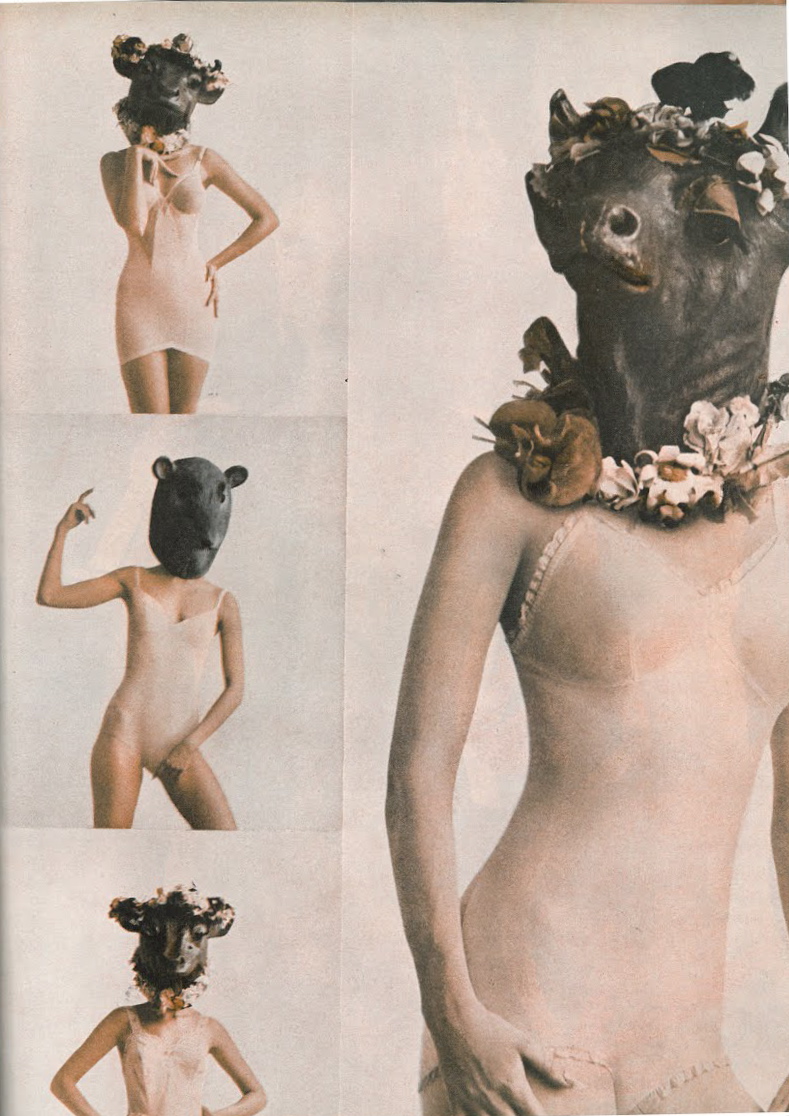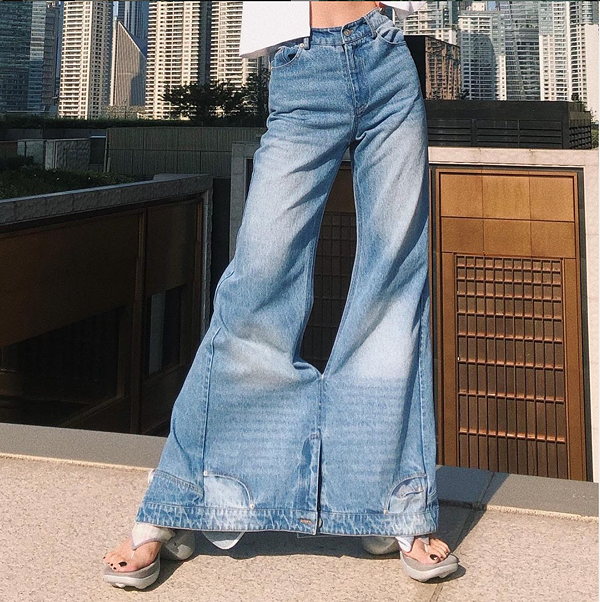Fashion
1965 Vogue Lingerie Feature
To see larger images of every page, go to link.CAUTION: NSFW pop-ups might intervene!


Posted By: Paul - Fri Aug 13, 2021 -
Comments (0)
Category: Animals, Anthropomorphism, Fashion, Underwear, Surrealism, 1960s
“in the Gay Nightlife of Rome, Trouser Parties Are Setting the Pace”
Posted By: Paul - Fri Aug 06, 2021 -
Comments (1)
Category: Fashion, 1960s, Women, United Kingdom
Double-Waist Jeans
New from Marrknull. Part of its Spring/Summer 2021 collection. They don't seem to be available for purchase yet.


Posted By: Alex - Sun Jul 25, 2021 -
Comments (4)
Category: Fashion, Denim
Vamp puffer
Designer xalamander is selling a "Vamp puffer" that's "stitched with intricate muscle detailing." Price tag: $660.00.

Posted By: Alex - Tue Jul 20, 2021 -
Comments (0)
Category: Body, Blood, Fashion
Yoko Ono, “Cut Piece”
To accompany Alex's Patty Chang post from yesterday.
Posted By: Paul - Mon Jun 21, 2021 -
Comments (0)
Category: Fashion, Performance Art, 1960s
Art-Necko Ties
Minnesota artist Mark Larson debuted his line of Art-Necko ties in 1978. These were plastic, see-through ties, and the gimmick was that he filled them with various stuff.
source: flickr
As described in the Minneapolis Star Tribune (Nov 26, 1978):
The neon tie, however, is the current front-runner. Larson's favorite, it's a stunning red-and-blue creation that makes a glowing statement about the wearer—providing he's hooked up to a power source.
And these have nothing on the proposed ties. There could be—well, the world's loudest tie (armed with a tiny loudspeaker to broadcast jets taking off); the horror movie or Vincent Price model (containing dry ice, with tiny holes in the front to permit the wearer to trail wisps of fog); the Fit-to-be-Tied Tie (a self-inflating strait-jacket that takes over when you feel you are losing control), and the chow mein tie, inspired by the Seal-a-Meal machine that is basic to the Art-Necko process.

The cowboy tie
People magazine (Jan 15, 1979) listed a few more:
Fishing Tackle features Goldfish crackers, a hook, sinker and a rubber worm. Vanity contains false eyelashes and phony fingernails. And for the ghoulish, there's Bones—scrubbed and boiled shortribs.
At the time the Art-Necko ties sold for $10. I found one for sale on eBay for $14.66. So not much increase in value in the past 40 years.
Posted By: Alex - Thu May 20, 2021 -
Comments (2)
Category: Art, Fashion, 1970s
Elephant Bells
A creation of the 1970s. The next level beyond bell-bottoms.

Tampa Bay Times - Oct 15, 1972
Posted By: Alex - Mon Apr 19, 2021 -
Comments (2)
Category: Fashion, 1970s
B-B-B Sweatshirts
Inexplicable fashion fad: In 1962, San Francisco adman Howard Gossage came up with the idea of putting the faces of classical composers on sweatshirts and selling them for $4. Consumers could choose between Beethoven, Bach, or Brahms. He quickly sold around 60,000 of them.If you want one of these sweatshirts today (at least, an original one), you'll have to pay significantly more. On eBay, the asking price ranges from $1500 all the way up to $9000.


Honolulu Star-Bulletin - May 4, 1962

Oakland Tribune - Feb 8, 1962
Posted By: Alex - Mon Apr 12, 2021 -
Comments (2)
Category: Fads, Fashion, Music, 1960s
Marilyke Fashion
In 1953, Reverend Bernard Kunkel of Bartelso, Illinois launched the Marilyke fashion movement. Dresses that were sufficiently modest, like the Virgin Mary would have worn (i.e. 'Marilyke'), were given a seal of approval in the form of a Marilyke tag they could display. The tags were "there to guide the Catholic girls."It seems that only wedding dresses and formal gowns were tagged. As Kunkel noted, "There's not much to be done about bathing suits... We strongly disapprove of the trend in modern bathing suits."
More info: Aliens in this world

source: University of Dayton


Detroit Free Press - June 13, 1955
Posted By: Alex - Fri Apr 09, 2021 -
Comments (3)
Category: Fashion, Religion, 1950s
Manly Bosoms Indecent
1934: Coney Island police continued to crack down on male bathers who adopted the new fashion of topless bathing suits.As for the female bathers:
"But if it's indecent we won't allow it," he said.

Windsor Star - May 15, 1934
Posted By: Alex - Mon Apr 05, 2021 -
Comments (1)
Category: Censorship, Bluenoses, Taboos, Prohibitions and Other Cultural No-No’s, Fashion, Swimming, Snorkeling, and Diving, 1930s

| Who We Are |
|---|
| Alex Boese Alex is the creator and curator of the Museum of Hoaxes. He's also the author of various weird, non-fiction, science-themed books such as Elephants on Acid and Psychedelic Apes. Paul Di Filippo Paul has been paid to put weird ideas into fictional form for over thirty years, in his career as a noted science fiction writer. He has recently begun blogging on many curious topics with three fellow writers at The Inferior 4+1. Contact Us |




